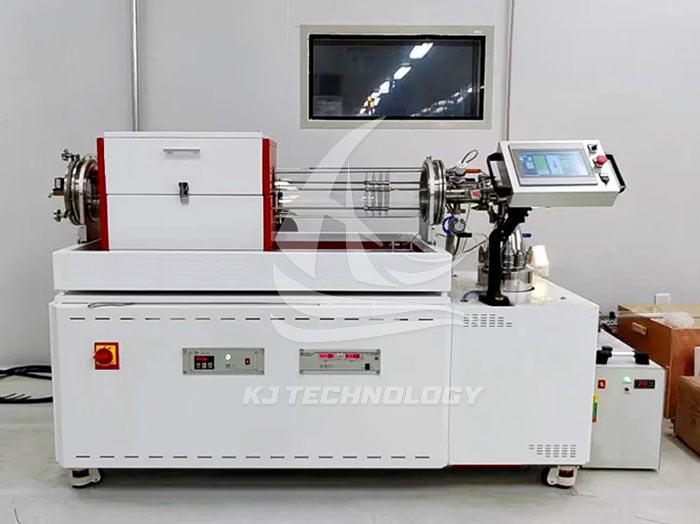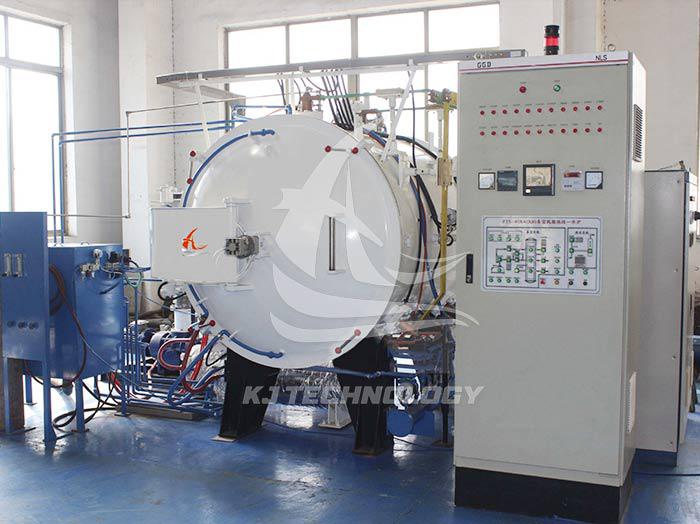Applicable process for vertical graphite carbon tube vacuum furnace
 10-17-2025 Author: KJ technology
10-17-2025 Author: KJ technology
The vertical graphite carbon tube vacuum furnace is suitable for various high-precision and high demand process scenarios due to its high temperature stability, efficient heat conduction, and vacuum environment control capabilities. The specific applicable processes are as follows:
1. Material Processing and Synthesis
Melting and Purification of Metal Alloys
Application scenario: Smelting high-purity metal alloys (such as titanium alloys and nickel based alloys) in a vacuum environment, removing gas impurities (such as hydrogen and oxygen), and improving material properties.
Technical advantages: The graphite carbon tube heating element can withstand high temperatures above 2000 ℃, coupled with a vacuum system (with a maximum vacuum degree of 5 × 10 ⁻ ³ Pa), effectively suppressing metal oxidation and ensuring melting purity.
Ceramic powder sintering
Application scenario: Sintering ceramic powders such as alumina and silicon nitride to achieve densification, improve bending strength and fracture toughness.
Technical advantages: The graphite carbon tube heating element is uniformly heated, combined with multi-layer insulation screens, with temperature uniformity within ± 5 ℃, meeting the requirements of precision ceramic sintering.
Preparation of nanomaterials
Application scenario: Synthesize nanomaterials such as carbon nanotubes and graphene, and regulate the diameter distribution by controlling temperature and gas ratio.
Technical advantages: The vacuum environment avoids the oxidation of nanomaterials, and the graphite carbon tube heating element provides a stable high-temperature field to support the growth of nanomaterials.
2. Semiconductor and Electronic Device Manufacturing
Annealing treatment of semiconductor materials
Application scenario: High temperature annealing of semiconductor materials such as monocrystalline silicon and silicon carbide (SiC) to eliminate internal stress and optimize crystal structure.
Technical advantages: precise temperature control (error ≤± 1 ℃), combined with inert gas (such as argon) protection, to avoid material oxidation and improve device performance.
thin film deposition
Application scenario: Deposition of metal or semiconductor thin films in a vacuum environment to ensure material purity and interface quality.
Technical advantages: The graphite carbon tube heating element provides a uniform thermal field and supports processes such as chemical vapor deposition (CVD) to improve the uniformity of thin films.
3. New energy material processing
Purification of battery materials
Application scenario: Purification of negative electrode materials for lithium-ion batteries (such as graphite, silicon carbon composite materials), removal of impurities and gases, and improvement of battery cycle life.
Technical advantages: Vacuum environment suppresses material oxidation, graphite carbon tube heating element provides high temperature field, and supports deep purification of materials.
Fuel cell component processing
Application scenario: Sintering fuel cell electrolyte membranes or electrode materials to optimize pore structure and conductivity.
Technical advantage: High temperature treatment under inert gas protection, avoiding material activity loss and improving fuel cell efficiency.
4. Aerospace and high-end manufacturing
Heat treatment of aircraft engine blades
Application scenario: High temperature annealing of titanium alloy blades to eliminate processing stress, refine grain size, and extend fatigue life.
Technical advantage: Annealing at 1100 ℃ under argon protection improves fatigue life and meets the stringent requirements of aviation engines.
Dehydration of titanium alloy components
Application scenario: Removing hydrogen embrittlement from titanium alloys through vacuum annealing, reducing the risk of fracture, and ensuring the safety of spacecraft.
Technical advantage: The high-temperature vacuum environment effectively extracts hydrogen elements, improving material reliability.
5. Laboratory research and pilot production
New material research and development
Application scenario: Provide high-temperature, vacuum or inert atmosphere environment for scientific research institutions, and support the exploration of new materials such as high-temperature superconducting materials and bioceramics.
Technical advantages: precise temperature control (± 1 ℃) and good experimental reproducibility, making it an important tool for researchers.
Small batch production
Application scenario: Meet the pilot needs of universities and enterprises, verify the feasibility of processes, and reduce the risks of large-scale production.
Technical advantages: Flexible configuration of process parameters, support for multi-stage programmed temperature control, and adaptability to different material processing needs.








